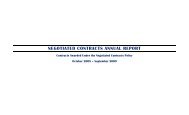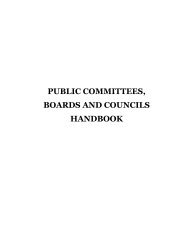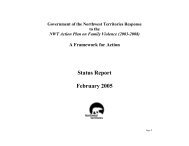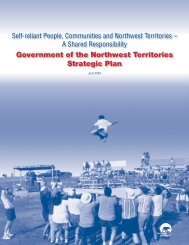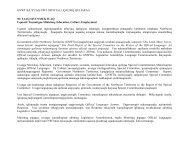Act Now - The Report of the WCB Legislative Review Panel to the
Act Now - The Report of the WCB Legislative Review Panel to the
Act Now - The Report of the WCB Legislative Review Panel to the
- No tags were found...
You also want an ePaper? Increase the reach of your titles
YUMPU automatically turns print PDFs into web optimized ePapers that Google loves.
3.6.2 System <strong>of</strong> Financial Compensation<strong>The</strong> <strong>Act</strong>s provide for a system <strong>of</strong> temporary and permanent financial compensation.<strong>The</strong> amount <strong>of</strong> temporary financial compensation is based on a calculation <strong>to</strong> replace aninjured worker’s wages while <strong>the</strong>y are recovering from a work-related accident ordisease. This is called a wage loss approach.<strong>The</strong> calculation starts with <strong>the</strong> worker’s “remuneration” as defined in <strong>the</strong> <strong>Act</strong>s (wages,overtime, etc.) <strong>to</strong> a maximum <strong>of</strong> <strong>the</strong> Year’s Maximum Insurable Remuneration (YMIR).Statu<strong>to</strong>ry deductions, such as income tax and Canada Pension Plan contributions, aresubtracted from <strong>the</strong> worker’s remuneration or YMIR, whichever is less, <strong>to</strong> come <strong>to</strong> afigure for a worker’s net pay. <strong>The</strong> temporary financial compensation is 90% <strong>of</strong> <strong>the</strong> netpay. <strong>The</strong> net pay is reduced by 10% because an injured worker will not incur expensesassociated with working, such as, transportation costs <strong>to</strong> and from <strong>the</strong> workplace. Thisreduction is standard among o<strong>the</strong>r jurisdictions and ranges from 10% <strong>to</strong> 25% <strong>of</strong> netincome and, in 2 jurisdictions, 25% <strong>of</strong> gross income.<strong>The</strong> amount <strong>of</strong> permanent financial compensation is based on a calculation that involves<strong>the</strong> percentage <strong>of</strong> disability or impairment <strong>the</strong> injured worker will always experience as aresult <strong>of</strong> <strong>the</strong> work-related injury or disease. This approach is called an impairment ordisability approach.<strong>The</strong> calculation starts with <strong>the</strong> injured worker’s remuneration, <strong>to</strong> a maximum <strong>of</strong> <strong>the</strong>YMIR, less statu<strong>to</strong>ry deductions, <strong>to</strong> arrive at <strong>the</strong> worker’s net remuneration. <strong>The</strong>percentage by which <strong>the</strong> worker is impaired or disabled is applied <strong>to</strong> 90% <strong>of</strong> <strong>the</strong> netremuneration and results in <strong>the</strong> amount <strong>of</strong> <strong>the</strong> permanent pension. <strong>The</strong> <strong>WCB</strong> usessomething called <strong>the</strong> Permanent Medical Impairment Guide that describes physical andpsychological impairment and assigns a numerical percentage <strong>to</strong> <strong>the</strong>se impairments.<strong>WCB</strong> <strong>Legislative</strong> <strong>Review</strong> <strong>Panel</strong> <strong>Report</strong> Page 51 <strong>of</strong> 128December, 2001






